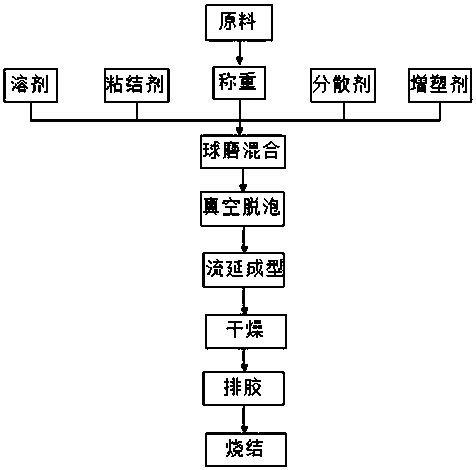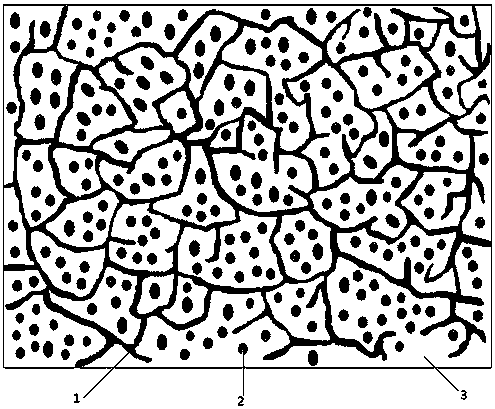A metal-ceramic composite substrate and its preparation process
A metal-ceramic composite and preparation technology, which is applied in the field of electronic packaging materials, can solve the problems of insufficient thermal matching of heat dissipation substrates and difficult to meet costs, and achieve the effects of natural fiber distribution, low efficiency and high efficiency
- Summary
- Abstract
- Description
- Claims
- Application Information
AI Technical Summary
Problems solved by technology
Method used
Image
Examples
Embodiment 1
[0037] Weigh nanometer Al according to volume percentage 2 o 3 50 parts of ceramic powder, 10 parts of copper fiber, ZnO-B with a melting point of 620°C 2 o 3 -SiO 2 40 parts of glass sintering aids, uniformly mixed into a mixed powder; then weigh 70% of the mixed powder, 14% of water, 9% of polyvinyl butyral, 6% of polyethylene glycol, three oils Glyceride 0.5%, defoaming agent 0.01%, film-forming aid 0.5%, ball milling and mixing for 48 hours, and the ball-milled cast slurry is vacuum defoamed under the condition of vacuum degree -0.1Mpa by a vacuum pump to eliminate ball milling The air mixed with the slurry; then the slurry treated by vacuum defoaming is tape-cast on a tape casting machine to form a 0.5mm thick ceramic green tape, and then dried; the dried ceramic green tape is sliced and sent to the row In the glue furnace, raise the temperature to 500°C, keep it for 1 hour, and get the ceramic green sheet after debinding; put the ceramic green sheet into the nitrog...
Embodiment 2
[0039] According to volume percentage, weigh 30 parts of cordierite ceramic powder, 40 parts of copper-zinc alloy fiber, commercially available ZnO-B with a melting point of 800°C 2 o 3 -SiO 230 parts of glass sintering aids, mixed uniformly to form a mixed powder; according to the mass percentage, weigh 62% of the mixed powder, 13% of water, 18% of polyvinyl butyral, 6% of polyethylene glycol, trioleic acid Glyceride 0.5%, defoamer 0.01%, film-forming aid 0.5% Weigh raw materials, ball mill and mix for 36 hours to prepare cast slurry; the ball-milled cast slurry is vacuum pumped at a vacuum degree of -0.1Mpa Carry out vacuum degassing under the conditions to eliminate the air mixed into the slurry in the ball mill; then cast the slurry treated by vacuum degassing on a tape casting machine; form a 3mm thick ceramic green belt, and then dry it; the dried The ceramic raw tape is sliced and sent to the debinding furnace, debinding in sections, heated to a temperature of 500°C...
Embodiment 3
[0041] Weigh Al according to volume percentage 2 o 3 35 parts of ceramic powder, 30 parts of aluminum fiber, commercially available ZnO-B with a melting point of 650°C 2 o 3 -SiO 2 35 parts of glass sintering aids, fully mixed evenly, weighed 50% of powder, 12% of water, 28% of polyvinyl butyral, 5.4% of polyethylene glycol, 1% of glyceryl trioleate, 0.1% of defoaming agent, 0.5% of film-forming aid, ball milling and mixing for 24 hours to prepare cast slurry, and vacuum defoaming of the ball-milled cast slurry by vacuum pump under the condition of vacuum degree -0.1Mpa to eliminate The air of the slurry is mixed in the ball mill; then the vacuum degassed slurry is cast on a tape casting machine to form a 2.5mm thick ceramic green tape, and then dried; the dried ceramic green tape is sliced and sent to the In the debinding furnace, degumming is performed in sections, the temperature is raised to 500°C, and kept for 1 hour, and the ceramic green sheet is obtained after de...
PUM
| Property | Measurement | Unit |
|---|---|---|
| diameter | aaaaa | aaaaa |
| melting point | aaaaa | aaaaa |
| melting point | aaaaa | aaaaa |
Abstract
Description
Claims
Application Information
 Login to View More
Login to View More - R&D
- Intellectual Property
- Life Sciences
- Materials
- Tech Scout
- Unparalleled Data Quality
- Higher Quality Content
- 60% Fewer Hallucinations
Browse by: Latest US Patents, China's latest patents, Technical Efficacy Thesaurus, Application Domain, Technology Topic, Popular Technical Reports.
© 2025 PatSnap. All rights reserved.Legal|Privacy policy|Modern Slavery Act Transparency Statement|Sitemap|About US| Contact US: help@patsnap.com



